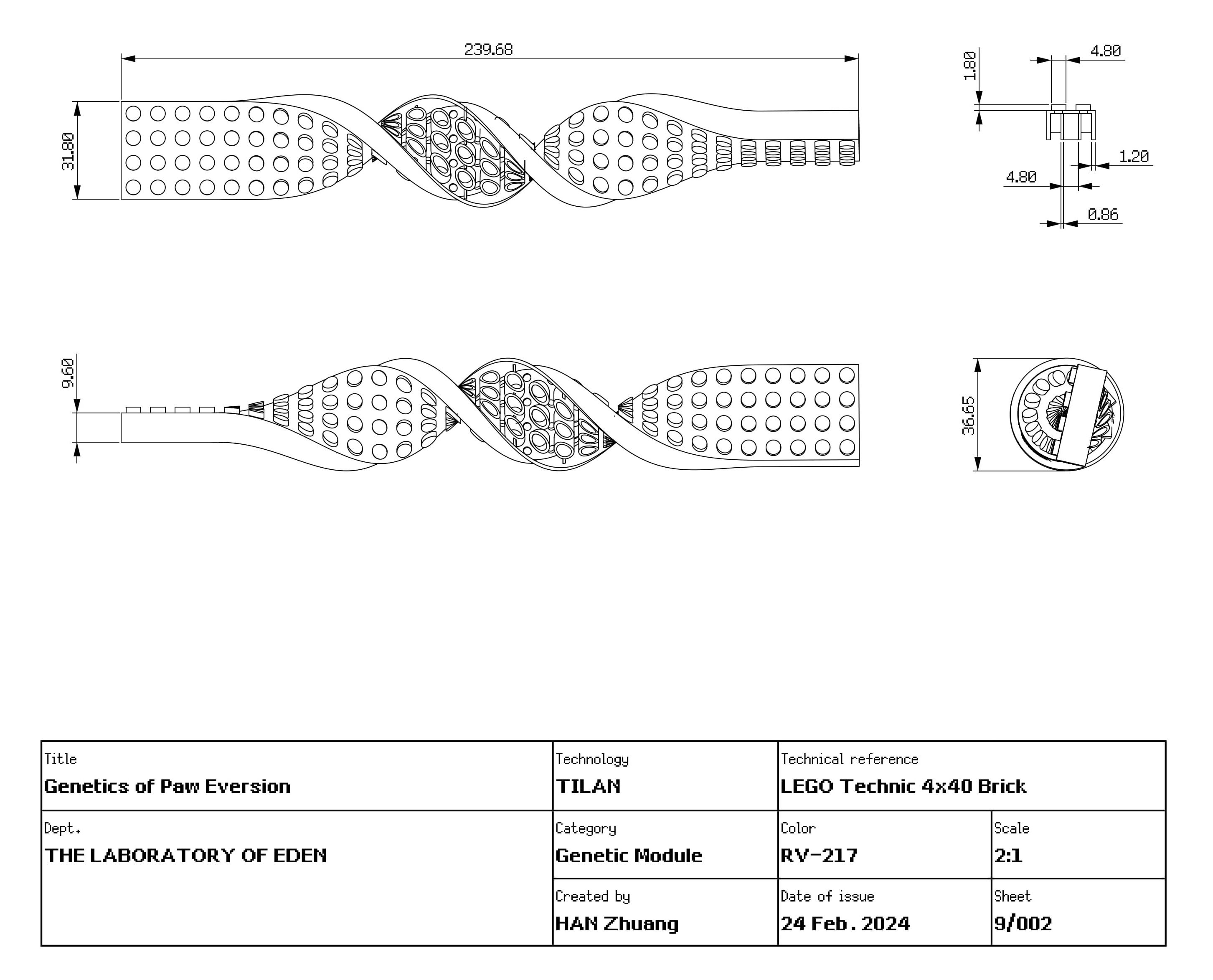Laboratory Background and Analysis
The Lab of Eden conducted an extensive analysis of claw eversion and identified significant hereditary links within the client’s family lineage. Laboratory studies indicate that claw eversion, as a prominent genetic marker, has been passed down through several generations. However, in critical hunting scenarios, particularly on complex terrains or during sharp directional changes, this trait offers no notable advantages. On the contrary, it is associated with reduced flexibility and decreased efficiency in high-demand physical activities.
The structural effects of claw eversion typically result in poor ground contact and reduced traction. This is particularly problematic when traversing uneven terrain or executing rapid direction changes, such as in chase or escape situations. Additionally, this trait may predispose the client to muscle strain and joint injuries during prolonged physical exertion or high-precision movements. These limitations suggest that claw eversion may represent a genetic liability in activities requiring agility and endurance.

Key Genetic Markers and Functions
| Genetic Marker | Genotype | Functional Description | Behavioral Manifestation |
|---|---|---|---|
| rs143383 | AA | This variant is associated with joint formation and flexibility. When expressed as AA, it is typically linked to slightly reduced joint stability, potentially increasing the risk of claw joint eversion. | Joints have lower tolerance to high-intensity movements, leading to reduced flexibility during high-speed running or sharp turns. |
| rs1800012 | GT | Regulates collagen synthesis, affecting the structural integrity of ligaments and tendons. GT genotype indicates moderate ligament strength, with a tendency toward insufficient support. | Increased likelihood of claw ligament injuries or fatigue, requiring extra caution during prolonged physical activity. |
| rs204098 | GG | Regulates skeletal and claw framework development. GG genotype often indicates a strong genetic predisposition toward skeletal curvature or eversion, potentially reducing natural claw alignment. | Decreased traction on complex terrain or during rapid directional changes, significantly limiting hunting efficiency and flexibility. |
Biological Parental Genetic Contribution
| Biological Parents | Key Genotype | Claw Structure Characteristics | Behavioral Manifestations |
|---|---|---|---|
| Biological Father | rs143383: AA | Exhibits slightly reduced ligament and joint stability, with claws prone to eversion under high-pressure conditions (e.g., high-speed running or sharp turns). | Limited athletic flexibility, higher energy consumption during demanding activities, and noticeable fatigue in high-speed hunting scenarios. |
| Biological Mother | rs1800012: GT | Displays a strong tendency toward claw skeletal curvature, though ligaments remain relatively stable, with overall claw eversion primarily occurring at the skeletal level. | Prone to claw soreness or strain after prolonged hunting or physical activity, requiring frequent rest to alleviate fatigue. |
Note :
- Both parents carry genotypes associated with eversion tendencies, resulting in an accumulated genetic risk for the offspring.
- While environmental or behavioral interventions can partially mitigate the effects, from a genetic perspective, the offspring are more likely to exhibit claw eversion characteristics.
Laboratory Model and Behavioral Manifestations
Laboratory Model: Genetic and Environmental Interaction
Genetic Influence
- Key genes associated with claw eversion (GDF5, COL1A1, RUNX2) determine the innate foundation of claw skeletal and ligament structure.
Environmental Amplification
- Growing up in uneven terrains and high-intensity hunting environments exacerbates claw eversion traits, further reducing traction and flexibility.
Epigenetics
- The expression of these genes may be upregulated or downregulated due to lifestyle factors and nutritional status.
Behavioral Manifestations
Reduced Hunting Agility
- The client struggles with high-speed sprints, sharp turns, and navigating narrow terrains, resulting in a higher error rate during hunts.
Claw Fatigue and Injury Prone
- Claws are prone to fatigue and ligament strain after prolonged activity, with an increased risk of chronic injuries from repeated high-stress movements.
Overall Lower Efficiency Compared to Non-Everted Individuals
Laboratory data shows that individuals with everted claws have higher energy consumption and lower hunting success rates.
Laboratory Recommendations and Next-Life Parent Matching
| Matching Direction | Recommended Parental Traits | Genetic Optimization Goals |
|---|---|---|
| Next-Life Father Traits | The father carries COL1A1 (TT) to enhance ligament strength, while the mother may carry GDF5 (GG) or RUNX2 (GT) to maintain relative skeletal balance. Using TILAN technology to fine-tune genetic risks. | Balance the offspring’s skeletal and ligament traits, ensuring they retain some flexibility while avoiding severe eversion. This allows for relatively stable performance in complex terrains and hunting scenarios. |
| Next-Life Mother Traits | One parent carries RUNX2 (GT) to moderately adjust skeletal development, while the other undergoes TILAN editing to incorporate protective alleles of COL1A1, improving the offspring’s ligament tensile strength. | Strengthen the stability of the skeletal-ligament connection, fundamentally reducing the likelihood of claw eversion. This ensures joint and ligament protection during high-intensity and long-distance running. |
| Genetic Optimization Focus | Both parents carry GDF5 (GG) and COL1A1 (TT), with TILAN technology used to enhance the balanced expression of RUNX2 for coordinated skeletal and soft tissue development. | Significantly improve joint and ligament stability in the offspring, making them better suited for high-intensity hunting and varied terrains. However, care should be taken to avoid excessive stability or rigidity, which could limit flexibility. |
Laboratory Conclusions and Research Directions
Core Conclusions
- Claw eversion is a structurally inherited trait with a strong familial genetic basis, closely associated with key genes such as GDF5, COL1A1, and RUNX2.
- This eversion trait poses limitations in high-speed, agile movements and hunting scenarios, while also increasing the risk of muscle and joint injuries.
- Through genetic matching and TILAN technology, it is possible to significantly reduce or mitigate this negative trait in future generations.
Future Research Directions
- Multi-Gene Interaction Mechanisms:Further investigate additional genes related to claw eversion (e.g., those involved in cartilage protein and tendon development) and their interactions with existing key genes.
- Epigenetic Intervention:Explore how nutrition, training, or environmental factors can further reduce eversion traits, including controllability of DNA methylation and histone modifications.
- Functional Rehabilitation and Training:Develop specialized rehabilitation or training programs targeted at individuals with eversion traits, aiming to maximize claw functionality and reduce injury risks in daily activities and hunting scenarios.